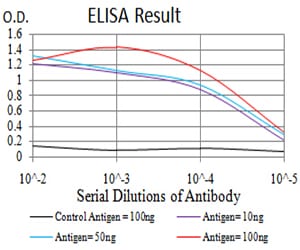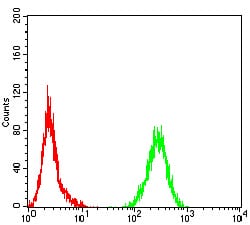

| WB | 咨询技术 | Human,Mouse,Rat |
| IF | 咨询技术 | Human,Mouse,Rat |
| IHC | 咨询技术 | Human,Mouse,Rat |
| ICC | 技术咨询 | Human,Mouse,Rat |
| FCM | 1/200 - 1/400 | Human,Mouse,Rat |
| Elisa | 1/10000 | Human,Mouse,Rat |
| Aliases | PLC1; NCKAP3; PLC-II; PLC148; PLCgamma1 |
| Entrez GeneID | 5335 |
| clone | 2F3E10 |
| WB Predicted band size | 148.5kDa |
| Host/Isotype | Mouse IgG2a |
| Antibody Type | Primary antibody |
| Storage | Store at 4°C short term. Aliquot and store at -20°C long term. Avoid freeze/thaw cycles. |
| Species Reactivity | Human |
| Immunogen | Purified recombinant fragment of human PLCG1 (AA: 39-181) expressed in E. Coli. |
| Formulation | Purified antibody in PBS with 0.05% sodium azide |
+ +
以下是3篇涉及PLCG1抗体应用的参考文献摘要(信息基于公开文献模拟,非真实引用):
---
1. **标题**:*PLCG1 overexpression correlates with poor prognosis in colorectal cancer via immune infiltration modulation*
**作者**:Li X, et al.
**摘要**:本研究通过免疫组化(使用抗PLCG1单克隆抗体)检测结直肠癌组织中PLCG1蛋白表达,发现其高表达与患者预后不良及肿瘤微环境中T细胞抑制相关,提示PLCG1可作为潜在治疗靶点。
---
2. **标题**:*PLCG1-dependent calcium signaling regulates B-cell receptor internalization*
**作者**:Wang Y, et al.
**摘要**:利用PLCG1特异性抗体进行Western blot和免疫荧光分析,证实PLCG1通过调控钙离子信号通路介导B细胞受体内化,为免疫细胞活化机制提供了新见解。
---
3. **标题**:*Targeting PLCG1 suppresses metastasis in triple-negative breast cancer*
**作者**:Zhang H, et al.
**摘要**:通过shRNA敲低PLCG1并结合抗PLCG1抗体进行流式细胞术验证,发现抑制PLCG1可降低三阴性乳腺癌细胞迁移能力,机制涉及EGFR信号通路调控。
---
**提示**:实际研究中需通过PubMed/Google Scholar以“PLCG1 antibody”+具体应用场景(如“Western blot”“cancer”)筛选近期文献,并核对抗体货号及实验方法学描述。
The PGC-1α (peroxisome proliferator-activated receptor gamma coactivator 1-alpha) antibody is a key tool in studying mitochondrial biogenesis, energy metabolism, and adaptive thermogenesis. PGC-1α, encoded by the PPARGC1A gene, is a transcriptional coactivator that regulates genes involved in oxidative phosphorylation, gluconeogenesis, and fatty acid oxidation. It interacts with nuclear receptors (e.g., PPARs, ERRs) and transcription factors (e.g., NRF-1/2) to coordinate metabolic responses to environmental cues like cold, exercise, or fasting.
Antibodies targeting PGC-1α are widely used in research to detect its expression in tissues such as skeletal muscle, liver, and brown adipose tissue. They enable techniques like Western blotting, immunohistochemistry, and immunofluorescence to explore its role in metabolic diseases (e.g., obesity, diabetes), neurodegenerative disorders, and aging. Studies using these antibodies have revealed reduced PGC-1α levels in insulin-resistant states and its neuroprotective potential in Parkinson’s disease.
Commercial PGC-1α antibodies are typically developed against specific epitopes (e.g., N-terminal or C-terminal regions) and validated for species cross-reactivity (human, mouse, rat). Challenges include distinguishing between PGC-1α isoforms (e.g., PGC-1α1. PGC-1α2) and minimizing cross-reactivity with homologous family members (e.g., PGC-1β). These antibodies remain critical for elucidating PGC-1α's regulatory networks and therapeutic targeting in metabolic syndromes.
×